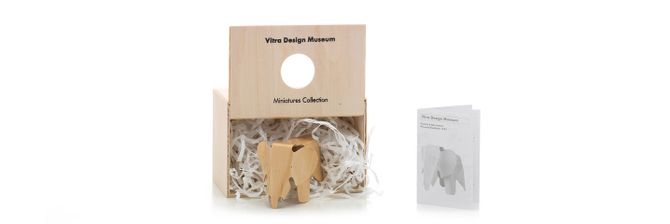
Miniatures Collection - Plywood Elephant natur
Charles & Ray Eames, 1945
Designed at the same time as their children's furniture, the Plywood Elephant can also be seen as a playful counterpart to the leg splints developed by the Eameses for military applications – which were the very first mass-produced objects made of threedimensionally moulded plywood.
Requiring complex fabrication methods, the Plywood Elephant never went into production. Only two prototypes were made, both of which were displayed at the New York Museumof Modern Art in 1945-46. Today only one known model remains in the possession of the Eames Family. In 2007 Vitra produced the first commercial production of the legendary Eames Plywood Elephant as a limited Collector's Edition.
Miniatures Collection
Durante más de dos décadas, el Vitra Design Museum ha hecho réplicas en miniatura de las piezas más importantes de su colección. La Miniatures Collection es un compendio de la historia del diseño de mobiliario industrial, desde el Historicismo y el Art Nouveau hasta la Bauhaus y la Nueva Objetividad, desde el Diseño Radical y el Posmodernismo hasta nuestros días. Con un tamaño que es exactamente un sexto del de los originales históricos, las sillas son fieles a la escala y reproducen hasta el menor detalle de construcción, material y color. La autenticidad llega incluso a la veta natural de la madera y a la reproducción de los tornillos y las complejas técnicas artesanales utilizadas. Por este motivo, las miniaturas se han convertido en objetos de colección muy populares y en un material didáctico ideal para universidades, escuelas de diseño y arquitectos.